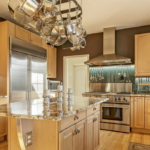
For the homeowner, kitchen remodels are among the most challenging forms of home improvement. The kitchen is often said to be the heart of the home because of how central the room is to family life. Family life tends to be disrupted when it is out of commission.
A kitchen remodel should involve a plan to manage the period of construction ahead. How long it will take depends on the project’s scope. How much do you intend to change? Do you want a new kitchen with the same footprint or do you want a completely new design?
If you are keeping the footprint, remodeling shouldn’t take more than six weeks at most; if you are making significant alterations, it might take up to three months. In either case, you will need to get yourself and members of your household ready for it. Here are some tips to help you prepare for a kitchen remodel:
Look at Designs Before the Project Begins
Consult an architect before you start moving walls. You need to make sure that your kitchen will function correctly. Your design should include adequate storage space and account for the ways to position appliances for maximum efficiency. Your architect will be able to spot any problems in your design. You should also get a timeline for the project from your contractor. Before your remodel begins, you should know exactly how long it will take. A timeline will also tell you how long you will have tradespeople going in and out of your home.
Choose the Right General Contractor
Your general contractor will be responsible for hiring the tradespeople for the project. You will be communicating with them about the project, so you need to find someone who will return calls and texts quickly.
Make Plans for Meal-Times
One option for living without a kitchen is to cook some or all of your meals in advance of the project’s start.
If you and your family normally eat in the kitchen, decide where you are going to eat once the remodel is underway. Consider your living-room if that’s what you’ve decided to use as your temporary kitchen. If you have a patio or deck, that can work too.
Get paper plates, plastic cutlery and cups so that you don’t have to wash your regular cutlery and dishes in the bathroom.
Come up with a budget for eating out at least a few nights a week while your kitchen is being remodeled. Planning ahead is important since this can get expensive quickly, especially if you have a large family. Factor the cost of eating out into the overall cost of your remodel.
Make Another Room Into Your Interim Kitchen
If you have space, use another room in your home as a short-term kitchen. Options include moving your refrigerator to your living room or your dining room. If space is limited, get a smaller refrigerator and microwave and plug those in somewhere else in your home. If you can’t devote a whole room or even half of a room, consider distributing essential kitchen appliances throughout your home.
Get an electric griddle to stand in for your stovetop, or invest in a hot plate. Plan a few meals that you can cook in a crockpot. All of these appliances can work wherever you have an electrical outlet. Another option is to use your outdoor grill. You can grill food on it and you can use it as a stove.
If you have a lot of small appliances and other items that you don’t plan to use before the remodel is finished, pack them away in boxes. Remember to use packing peanuts or bubble wrap for items like china and glasses. Store the boxes away in your spare bedroom or basement and be sure to label them. Labeling makes unpacking easier and reminds you which boxes contain breakables.
Seal Off the Kitchen
Anyone who has ever lived through a remodel will tell you that they are not tidy. You will need a plan for keeping the rest of your house clean all the way through until the project is complete. Sealing off your kitchen can help to minimize the spread of dust and dirt to the rest of your home.
Get the Kitchen Ready
If you plan on doing the demolition yourself start with the following: disconnect the gas from your range and electricity from any of your hard-wired appliances such as ovens and dishwashers. Do your light fixtures have glass covers? If so, remove them. Remove covers over your electrical outlets as well. Heat register and window covers should all be removed.
Move all of your appliances out of the kitchen. If you have a vessel sink that sits above the countertop, lift it out and remove the faucet. Take out the backsplash and countertop. If you have wall tiles, those have to go too. Use a drill or pry bar to remove cabinets. Use a pry bar to pull drywall off the ceiling and walls but be careful around electrical wiring and ductwork. If there is no asbestos in the floor, pull up the linoleum of other flooring and then finish it all up by cleaning up the waste and dust.
Make Plans for Pets
A remodel can be stressful for pets. Not only will they kept out of the kitchen while it is under construction, but there will also be new loud noises and strangers going in and out. You may want to find them temporary homes or at least kennel them as far as possible from the kitchen.
If you are planning to remodel your kitchen, planning and preparation are crucial for getting through the process. We can help. Use our contact form to reach out to us.






